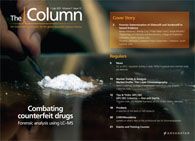Termite study
A study of the processes that termites use to break down plant cell walls could provide new enzymatic pretreatment processes for the production of biofuels.
A study of the processes that termites use to break down plant cell walls could provide new enzymatic pretreatment processes for the production of biofuels.
Termites are highly effective at degrading plant biomass including lignin but the process by which they do this is still not well understood. A study published in Biotechnology for Biofuels,1 has investigated the structural modification caused by termites in the lignin biomolecular assembly in softwood tissues crucial for cell-wall degradation. Termite-digested and native softwood tissues were compared using 13C crosspolarization magic angle spinning and nuclear magnetic resonance spectroscopy, Flash pyrolysis with gas chromatography–mass spectrometry (Py-GC–MS), and Py-GC–MS in the presence of tetramethylammonium hydroxide (Py-TMAH)-GC–MS.
Spectroscopic analysis, confirmed by the Py-GC–MS data indicated dehydroxylation and modification of selective intermonomer side-chain linkages. Moreover, Py-TMAH-GC–MS analysis showed significant differences in the product distribution, which the researchers report strongly suggests that the structural modification in lignin could be associated with the formation of additional condensed interunit linkages. The study concluded that these results provide insight into lignin-unlocking mechanisms for understanding plant cell-wall deconstruction, which could be useful in the development of new processes mimicking the termite system for biochemical conversion of lignocellulosic biomass to fuels and chemicals.
1. J. Ke, Biotechnology for Biofuels, 4(17) (2011).
This story originally appeared in The Column. Click here to view that issue.
Free Poster: NDSRI Risk Assessment and Trace-Level Analysis of N-Nitrosamines
April 25th 2025With increasing concern over genotoxic nitrosamine contaminants, regulatory bodies like the FDA and EMA have introduced strict guidelines following several high-profile drug recalls. This poster showcases a case study where LGC and Waters developed a UPLC/MS/MS method for quantifying trace levels of N-nitroso-sertraline in sertraline using Waters mass spectrometry and LGC reference standards.
New Guide: Characterising Impurity Standards – What Defines “Good Enough?”
April 25th 2025Impurity reference standards (IRSs) are essential for accurately identifying and quantifying impurities in pharmaceutical development and manufacturing. Yet, with limited regulatory guidance on how much characterisation is truly required for different applications, selecting the right standard can be challenging. To help, LGC has developed a new interactive multimedia guide, packed with expert insights to support your decision-making and give you greater confidence when choosing the right IRS for your specific needs.
Using the Carcinogenic Potency Categorisation Approach (CPCA) to Classify N-nitrosamine Impurities
April 25th 2025Learn how to manage nitrosamine impurities in pharmaceuticals with our free infographic. Discover how the CPCA approach establishes acceptable intake limits and guides the selection of NDSRI reference samples. Stay compliant and ensure safety with our ISO-accredited standards.

.png&w=3840&q=75)

.png&w=3840&q=75)



.png&w=3840&q=75)



.png&w=3840&q=75)











